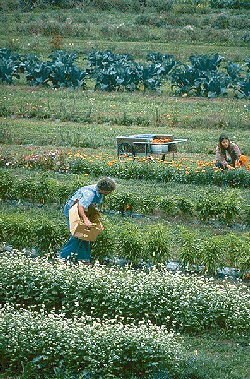 An article in this morning’s NY Times calls into question whether or not local food is actually better, if you’re concerned about reducing energy consumption. (See Food That Travels Well, by James E. McWilliams, who wrote “A Revolution in Eating: How the Quest for Food Shaped America†and is a contributing writer for The Texas Observer. What’s the story on this guy, Austin folks?)
An article in this morning’s NY Times calls into question whether or not local food is actually better, if you’re concerned about reducing energy consumption. (See Food That Travels Well, by James E. McWilliams, who wrote “A Revolution in Eating: How the Quest for Food Shaped America†and is a contributing writer for The Texas Observer. What’s the story on this guy, Austin folks?)
An example he provides is New Zealand lamb imported to England. Sheep put on weight very efficiently on the famously lush New Zealand pastures. Sheep in England need to be fed energy-intensive grains — enough apparently to make it cheaper (from an energy-use perspective) to ship lamb from down under.
This is no surprise to American dairy farmers. They know how much cheaper it is for pasture-based New Zealand dairies to ship milk powder into the U.S. market than it is for us to produce it here. Another counterintuitive example I’ve read concerns spuds. Turns out taters shipped by rail from Idaho to New York City use less energy than trucking potatoes to the Big Apple from Maine.
I don’t think this blows the local foods movement out of the water. But it does mean that we might need to be a little more sophisticated in our thinking about this issue.
This also reminds me that this whole local foods thing isn’t new. I remember when I first worked for Rodale back in the early ’80s. They sponsored The Cornucopia Project. The project staff did studies of how much food was imported and exported by each state and pointed out how many ‘food miles’ (as they’re called now) were invested in different commodities in different locales.
But the big thing I remember about their findings: When you think about all the energy that goes into the fertilizers and the plowing and the processing and the packaging and the shipping, do you know the least efficient step in the whole food system from farm to table?
Hopping in the car and driving to the store to return home with an average of 33 pounds of groceries.
Note on the image above: It’s an old one that I found on my hard drive, almost certainly shot in the ’80s by my old friend Tom Gettings, former photo director at Rodale Press. The farmers there are heroes — Ward Sinclair and Cass Peterson. Ward used to work the farm policy beat at the Washington Post before he and Cass started farming. Before CSAs were hot, they used to haul ‘shares’ to the WaPo’s offices during the season to appreciative co-workers. Ward died way too soon. I’ve lost track of what Cass is up to these days. But if there were a Sustainable Farming Hall of Fame, they would be charter members.
Update: Much discussion of McWilliams article at ReasonOnline.


 An article in this morning’s NY Times calls into question whether or not local food is actually better, if you’re concerned about reducing energy consumption. (See
An article in this morning’s NY Times calls into question whether or not local food is actually better, if you’re concerned about reducing energy consumption. (See